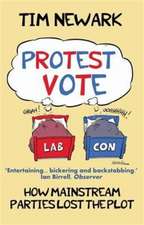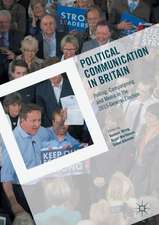The Mathematics of Elections and Voting
Autor W.D. Wallisen Limba Engleză Paperback – 24 oct 2014
Preț: 443.75 lei
Nou
Puncte Express: 666
Preț estimativ în valută:
84.91€ • 88.65$ • 70.27£
84.91€ • 88.65$ • 70.27£
Carte tipărită la comandă
Livrare economică 04-18 aprilie
Preluare comenzi: 021 569.72.76
Specificații
ISBN-13: 9783319098098
ISBN-10: 3319098098
Pagini: 96
Ilustrații: X, 96 p.
Dimensiuni: 155 x 235 x 8 mm
Greutate: 0.16 kg
Ediția:2014
Editura: Springer International Publishing
Colecția Springer
Locul publicării:Cham, Switzerland
ISBN-10: 3319098098
Pagini: 96
Ilustrații: X, 96 p.
Dimensiuni: 155 x 235 x 8 mm
Greutate: 0.16 kg
Ediția:2014
Editura: Springer International Publishing
Colecția Springer
Locul publicării:Cham, Switzerland
Public țintă
Upper undergraduateCuprins
1.Introduction.- 2.Simple Elections I.- 3. Simple Elections II - Condorcet's Method.- 4. Fair Elections; Polls; Amendments.- 5. Arrow’s Theorem and the Gibbard-Satterthwaite Theorem.- 6. Complex Elections.- 7. Cardinal Systems.- 8. Weighted Voting. References.
Recenzii
From the book reviews:
“This concise volume is an introduction to various voting schemes and electoral systems. … the book gives a good picture of the range of voting systems that exist and some of the reasons they are used in certain situations. It is most suitable for undergraduates with some knowledge of combinatorics and proof, who are beginning to study elections and voting.” (Matthew Davis, zbMATH, Vol. 1305, 2015)
“This concise volume is an introduction to various voting schemes and electoral systems. … the book gives a good picture of the range of voting systems that exist and some of the reasons they are used in certain situations. It is most suitable for undergraduates with some knowledge of combinatorics and proof, who are beginning to study elections and voting.” (Matthew Davis, zbMATH, Vol. 1305, 2015)
Notă biografică
W. D. Wallis served as a Professor of Mathematics at Southern Illinois University, Carbondale, for 24 years up until his retirement in 2009. Before that he taught for 15 years at the University of Newcastle, Australia, and for 4 years at La Trobe University, Australia. His main areas of research have been in Combinatorial Mathematics and Graph Theory. He has also published some work in Computer Science and in Algebra. He has authored or co-authored fourteen books on Mathematics, together with some second editions, and edited nine books. He has published 268 research articles and book chapters.
Textul de pe ultima copertă
The Mathematics of Elections and Voting takes an in-depth look at the mathematics in the context of voting and electoral systems, with focus on simple ballots, complex elections, fairness, approval voting, ties, fair and unfair voting, and manipulation techniques. The exposition opens with a sketch of the mathematics behind the various methods used in conducting elections. The reader is lead to a comprehensive picture of the theoretical background of mathematics and elections through an analysis of Condorcet’s Principle and Arrow’s Theorem of conditions in electoral fairness. Further detailed discussion of various related topics include: methods of manipulating the outcome of an election, amendments, and voting on small committees.
In recent years, electoral theory has been introduced into lower-level mathematics courses, as a way to illustrate the role of mathematics in our everyday life. Few books have studied voting and elections from a more formal mathematical viewpoint. This text will be useful to those who teach lower level courses or special topics courses and aims to inspire students to understand the more advanced mathematics of the topic. The exercises in this text are ideal for upper undergraduate and early graduate students, as well as those with a keen interest in the mathematics behind voting and elections.
In recent years, electoral theory has been introduced into lower-level mathematics courses, as a way to illustrate the role of mathematics in our everyday life. Few books have studied voting and elections from a more formal mathematical viewpoint. This text will be useful to those who teach lower level courses or special topics courses and aims to inspire students to understand the more advanced mathematics of the topic. The exercises in this text are ideal for upper undergraduate and early graduate students, as well as those with a keen interest in the mathematics behind voting and elections.
Caracteristici
Contains exercises and could be used as a text for a special topics course Discuss majority and plurality voting, runoff elections and the Hare method Looks at elections where points are allocated to the candidates and the high scorer wins Includes supplementary material: sn.pub/extras










